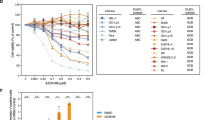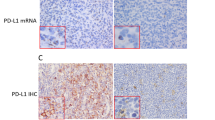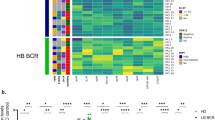Abstract
Diffuse large B-cell lymphoma (DLBCL) is a biologically and clinically heterogeneous disease with marked genomic instability and variable response to conventional R-CHOP (rituximab, cyclophosphamide, doxorubicin, vincristine and prednisone) chemotherapy. More clinically aggressive cases of DLBCLs have high level of circulating interleukin 10 (IL10) cytokine and evidence of activated intracellular STAT3 (signal transducer and activator of transcription 3) signaling. We investigated the role of IL10 and its surface receptor in supporting the neoplastic phenotype of DLBCLs. We determined that IL10RA gene is amplified in 21% and IL10RB gene in 10% of primary DLBCLs. Gene expression of IL10, IL10RA and IL10RB was markedly elevated in DLBCLs. We hypothesized that DLBCLs depend for their proliferation and survival on IL10-STAT3 signaling and that blocking the IL10 receptor (IL10R) would induce cell death. We used anti-IL10R blocking antibody, which resulted in a dose-dependent cell death in all tested activated B-cell-like subtype of DLBCL cell lines and primary DLBCLs. Response of germinal center B-cell-like subtype of DLBCL cell lines to anti-IL10R antibody varied from sensitive to resistant. Cells underwent cell cycle arrest, followed by induction of apoptosis. Cell death depended on inhibition of STAT3 and, to a lesser extent, STAT1 signaling. Anti-IL10R treatment resulted in interruption of IL10-IL10R autostimulatory loop. We thus propose that IL10R is a novel therapeutic target in DLBCLs.
This is a preview of subscription content, access via your institution
Access options
Subscribe to this journal
Receive 12 print issues and online access
$259.00 per year
only $21.58 per issue
Buy this article
- Purchase on Springer Link
- Instant access to full article PDF
Prices may be subject to local taxes which are calculated during checkout





Similar content being viewed by others
References
Coiffier B . Diffuse large cell lymphoma. Curr Opin Oncol 2001; 13: 325–334.
Alizadeh AA, Eisen MB, Davis RE, Ma C, Lossos IS, Rosenwald A et al. Distinct types of diffuse large B-cell lymphoma identified by gene expression profiling. Nature 2000; 403: 503–511.
Rosenwald A, Wright G, Chan WC, Connors JM, Campo E, Fisher RI et al. The use of molecular profiling to predict survival after chemotherapy for diffuse large-B-cell lymphoma. N Engl J Med 2002; 346: 1937–1947.
Ding BB, Yu JJ, Yu RY, Mendez LM, Shaknovich R, Zhang Y et al. Constitutively activated STAT3 promotes cell proliferation and survival in the activated B-cell subtype of diffuse large B-cell lymphomas. Blood 2008; 111: 1515–1523.
Lam LT, Wright G, Davis RE, Lenz G, Farinha P, Dang L et al. Cooperative signaling through the signal transducer and activator of transcription 3 and nuclear factor-{kappa}B pathways in subtypes of diffuse large B-cell lymphoma. Blood 2008; 111: 3701–3713.
Goode I, Xu H, Ildstad ST . Regulatory B cells: the new 'it' cell. Transplant Proc 2013; 46: 3–8.
Lu X, Nechushtan H, Ding F, Rosado MF, Singal R, Alizadeh AA et al. Distinct IL-4-induced gene expression, proliferation, and intracellular signaling in germinal center B-cell-like and activated B-cell-like diffuse large-cell lymphomas. Blood 2005; 105: 2924–2932.
Deenick EK, Avery DT, Chan A, Berglund LJ, Ives ML, Moens L et al. Naive and memory human B cells have distinct requirements for STAT3 activation to differentiate into antibody-secreting plasma cells. J Exp Med 2013; 210: 2739–2753.
Rutsch S, Neppalli VT, Shin DM, DuBois W, Morse HC III, Goldschmidt H et al. IL-6 and MYC collaborate in plasma cell tumor formation in mice. Blood 2010; 115: 1746–1754.
Zheng MM, Zhang Z, Bemis K, Belch AR, Pilarski LM, Shively JE et al. The systemic cytokine environment is permanently altered in multiple myeloma. PLoS One 2013; 8: e58504.
Soutar RL, Dillon JM, Brown D, Ralston SH . Cytokine expression in multiple myeloma and monoclonal gammopathy: analysis by reverse transcription/polymerase chain reaction and quantitative PCR. Leuk Lymphoma 1996; 24: 111–120.
Sati HI, Apperley JF, Greaves M, Lawry J, Gooding R, Russell RG et al. Interleukin-6 is expressed by plasma cells from patients with multiple myeloma and monoclonal gammopathy of undetermined significance. Br J Haematol 1998; 101: 287–295.
Rousset F, Garcia E, Defrance T, Peronne C, Vezzio N, Hsu DH et al. Interleukin 10 is a potent growth and differentiation factor for activated human B lymphocytes. Proc Natl Acad Sci USA 1992; 89: 1890–1893.
Czarneski J, Lin YC, Chong S, McCarthy B, Fernandes H, Parker G et al. Studies in NZB IL-10 knockout mice of the requirement of IL-10 for progression of B-cell lymphoma. Leukemia 2004; 18: 597–606.
Voorzanger N, Touitou R, Garcia E, Delecluse HJ, Rousset F, Joab I et al. Interleukin (IL)-10 and IL-6 are produced in vivo by non-Hodgkin's lymphoma cells and act as cooperative growth factors. Cancer Res 1996; 56: 5499–5505.
Gupta M, Han JJ, Stenson M, Maurer M, Wellik L, Hu G et al. Elevated serum IL-10 levels in diffuse large B-cell lymphoma: a mechanism of aberrant JAK2 activation. Blood 2012; 119: 2844–2853.
Zdanov A . Structural analysis of cytokines comprising the IL-10 family. Cytokine Growth Factor Rev 2010; 21: 325–330.
Moore KW, de Waal Malefyt R, Coffman RL, O'Garra A . Interleukin-10 and the interleukin-10 receptor. Annu Rev Immunol 2001; 19: 683–765.
Matesanz-Isabel J, Sintes J, Llinas L, de Salort J, Lazaro A, Engel P . New B-cell CD molecules. Immunol Lett 2011; 134: 104–112.
Yoon SI, Logsdon NJ, Sheikh F, Donnelly RP, Walter MR . Conformational changes mediate interleukin-10 receptor 2 (IL-10R2) binding to IL-10 and assembly of the signaling complex. J Biol Chem 2006; 281: 35088–35096.
Akira S, Nishio Y, Inoue M, Wang XJ, Wei S, Matsusaka T et al. Molecular cloning of APRF, a novel IFN-stimulated gene factor 3 p91-related transcription factor involved in the gp130-mediated signaling pathway. Cell 1994; 77: 63–71.
Yang J, Liao X, Agarwal MK, Barnes L, Auron PE, Stark GR . Unphosphorylated STAT3 accumulates in response to IL-6 and activates transcription by binding to NFkappaB. Genes Dev 2007; 21: 1396–1408.
Yoshida Y, Kumar A, Koyama Y, Peng H, Arman A, Boch JA et al. Interleukin 1 activates STAT3/nuclear factor-kappaB cross-talk via a unique TRAF6- and p65-dependent mechanism. J Biol Chem 2004; 279: 1768–1776.
Shaknovich R, Geng H, Johnson NA, Tsikitas L, Cerchietti L, Greally JM et al. DNA methylation signatures define molecular subtypes of diffuse large B-cell lymphoma. Blood 2010; 116: e81–e89.
Caron G, Le Gallou S, Lamy T, Tarte K, Fest T . CXCR4 expression functionally discriminates centroblasts versus centrocytes within human germinal center B cells. J Immunol 2009; 182: 7595–7602.
Irizarry RA, Hobbs B, Collin F, Beazer-Barclay YD, Antonellis KJ, Scherf U et al. Exploration, normalization, and summaries of high density oligonucleotide array probe level data. Biostatistics 2003; 4: 249–264.
Dai M, Wang P, Boyd AD, Kostov G, Athey B, Jones EG et al. Evolving gene/transcript definitions significantly alter the interpretation of GeneChip data. Nucleic Acids Res 2005; 33: e175.
Smyth GK . Linear models and empirical bayes methods for assessing differential expression in microarray experiments. Statist Appl Genet Mol Biol 2004; 3: Article3.
Chambwe N, Kormaksson M, Geng H, De S, Michor F, Johnson NA et al. Variability in DNA methylation defines novel epigenetic subgroups of DLBCL associated with different clinical outcomes. Blood 2014; 123: 1699–1708.
Beroukhim R, Getz G, Nghiemphu L, Barretina J, Hsueh T, Linhart D et al. Assessing the significance of chromosomal aberrations in cancer: methodology and application to glioma. Proc Natl Acad Sci USA 2007; 104: 20007–20012.
Brooks DG, Trifilo MJ, Edelmann KH, Teyton L, McGavern DB, Oldstone MB . Interleukin-10 determines viral clearance or persistence in vivo. Nat Med 2006; 12: 1301–1309.
Ganetsky A . Ruxolitinib: a new treatment option for myelofibrosis. Pharmacotherapy 2013; 33: 84–92.
Bai W, Liu H, Ji Q, Zhou Y, Liang L, Zheng R et al. TLR3 regulates mycobacterial RNA-induced IL-10 production through the PI3K/AKT signaling pathway. Cell Signal 2014; 26: 942–950.
Strle K, Zhou JH, Broussard SR, Venters HD, Johnson RW, Freund GG et al. IL-10 promotes survival of microglia without activating Akt. J Neuroimmunol 2002; 122: 9–19.
Ci W, Polo JM, Cerchietti L, Shaknovich R, Wang L, Yang SN et al. The BCL6 transcriptional program features repression of multiple oncogenes in primary B cells and is deregulated in DLBCL. Blood 2009; 113: 5536–5548.
Cerchietti LC, Yang SN, Shaknovich R, Hatzi K, Polo JM, Chadburn A et al. A peptomimetic inhibitor of BCL6 with potent antilymphoma effects in vitro and in vivo. Blood 2009; 113: 3397–3405.
Lim KH, Yang Y, Staudt LM . Pathogenetic importance and therapeutic implications of NF-kappaB in lymphoid malignancies. Immunol Rev 2012; 246: 359–378.
Staudt LM . Oncogenic activation of NF-kappaB. Cold Spring Harbor Perspect Biol 2010; 2: a000109.
Davis RE, Brown KD, Siebenlist U, Staudt LM . Constitutive nuclear factor kappaB activity is required for survival of activated B cell-like diffuse large B cell lymphoma cells. J Exp Med 2001; 194: 1861–1874.
Kalampokis I, Yoshizaki A, Tedder TF . IL-10-producing regulatory B cells (B10 cells) in autoimmune disease. Arthritis Res Ther 2013; 15: S1.
Matsuda M, Salazar F, Petersson M, Masucci G, Hansson J, Pisa P et al. Interleukin 10 pretreatment protects target cells from tumor- and allo-specific cytotoxic T cells and downregulates HLA class I expression. J Exp Med 1994; 180: 2371–2376.
Harrison C, Mesa R, Ross D, Mead A, Keohane C, Gotlib J et al. Practical management of patients with myelofibrosis receiving ruxolitinib. Expert Rev Hematol 2013; 6: 511–523.
Verstovsek S, Mesa RA, Gotlib J, Levy RS, Gupta V, DiPersio JF et al. A double-blind, placebo-controlled trial of ruxolitinib for myelofibrosis. N Engl J Med 2012; 366: 799–807.
Yamaoka K, Tanaka Y . Jak inhibitor; possibility and mechanism as a new disease modifying anti-rheumatic drug. Jpn J Clin Immunol 2009; 32: 85–91.
Pardanani A, Lasho T, Smith G, Burns CJ, Fantino E, Tefferi A . CYT387, a selective JAK1/JAK2 inhibitor: in vitro assessment of kinase selectivity and preclinical studies using cell lines and primary cells from polycythemia vera patients. Leukemia 2009; 23: 1441–1445.
Williams NK, Bamert RS, Patel O, Wang C, Walden PM, Wilks AF et al. Dissecting specificity in the Janus kinases: the structures of JAK-specific inhibitors complexed to the JAK1 and JAK2 protein tyrosine kinase domains. J Mol Biol 2009; 387: 219–232.
Manshouri T, Quintas-Cardama A, Nussenzveig RH, Gaikwad A, Estrov Z, Prchal J et al. The JAK kinase inhibitor CP-690,550 suppresses the growth of human polycythemia vera cells carrying the JAK2V617F mutation. Cancer Sci 2008; 99: 1265–1273.
Lichtenstein A, Tu Y, Fady C, Vescio R, Berenson J . Interleukin-6 inhibits apoptosis of malignant plasma cells. Cell Immunol 1995; 162: 248–255.
Umezawa K . Possible role of peritoneal NF-kappaB in peripheral inflammation and cancer: lessons from the inhibitor DHMEQ. Biomed Pharmacother Biomed Pharmacother 2011; 65: 252–259.
Horiguchi Y, Kuroda K, Nakashima J, Murai M, Umezawa K . Antitumor effect of a novel nuclear factor-kappa B activation inhibitor in bladder cancer cells. Expert review of anticancer therapy 2003; 3: 793–798.
Yasuda A, Kondo S, Nagumo T, Tsukamoto H, Mukudai Y, Umezawa K et al. Anti-tumor activity of dehydroxymethylepoxyquinomicin against human oral squamous cell carcinoma cell lines in vitro and in vivo. Oral oncology 2011; 47: 334–339.
Shimada C, Ninomiya Y, Suzuki E, Umezawa K . Efficient cellular uptake of the novel NF-kappaB inhibitor (-)-DHMEQ and irreversible inhibition of NF-kappaB in neoplastic cells. Oncology research 2010; 18: 529–535.
Acknowledgements
This work was supported by the start up fund from the Department of Medicine WCMC and a generous gift from Bob Horne and Laurie Lindenbaum. We thank Robert Bichard for editing the paper.
Author Contributions
WB designed and performed research and analyzed data; SS, JWC, AC and LT collected data and performed research; NC, FCC, YJ and HG analyzed data and performed statistical analysis; DS, WT, GB and RDG contributed with patient samples and interpreted data; RS designed research, interpreted data and wrote the manuscript.
Author information
Authors and Affiliations
Corresponding author
Ethics declarations
Competing interests
The authors declare no conflict of interest.
Additional information
Supplementary Information accompanies this paper on the Leukemia website
Supplementary information
Rights and permissions
About this article
Cite this article
Béguelin, W., Sawh, S., Chambwe, N. et al. IL10 receptor is a novel therapeutic target in DLBCLs. Leukemia 29, 1684–1694 (2015). https://doi.org/10.1038/leu.2015.57
Received:
Revised:
Accepted:
Published:
Issue Date:
DOI: https://doi.org/10.1038/leu.2015.57
This article is cited by
-
A peptide derived from interleukin-10 exhibits potential anticancer activity and can facilitate cell targeting of gold nanoparticles loaded with anticancer therapeutics
Communications Chemistry (2023)
-
Regulatory T cells promote the stemness of leukemia stem cells through IL10 cytokine-related signaling pathway
Leukemia (2022)
-
Changes in cerebrospinal fluid interleukin-10 levels display better performance in predicting disease relapse than conventional magnetic resonance imaging in primary central nervous system lymphoma
BMC Cancer (2021)
-
An inflammation-based cumulative prognostic score system in patients with diffuse large B cell lymphoma in rituximab era
BMC Cancer (2018)
-
Novel drug targets for personalized precision medicine in relapsed/refractory diffuse large B-cell lymphoma: a comprehensive review
Molecular Cancer (2015)



